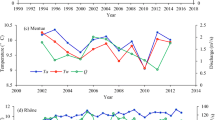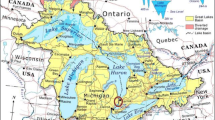Abstract
Accurate estimation of streamflow has a vital importance in water resources engineering, management and planning. In the present study, the abilities of group method of data handling-neural networks (GMDH-NN), dynamic evolving neural-fuzzy inference system (DENFIS) and multivariate adaptive regression spline (MARS) methods are investigated for monthly streamflow prediction. Precipitation, temperature and streamflows from Kalam and Chakdara stations at Swat River basin (mountainous basin), Pakistan, are used as inputs to the applied models in the form of different input scenarios, and models’ performances are evaluated on the basis of root mean square error (RMSE), mean absolute error (MAE), Nash–Sutcliffe efficiency (NSE) and combined accuracy (CA) indexes. Test results of the Kalam Station show that the DENFIS model provides more accurate prediction results in comparison of GMDH-NN and MARS models with the lowest RMSE (18.9 m3/s), MAE (13.1 m3/s), CA (10.6 m3/s) and the highest NSE (0.941). For the Chakdara Station, the MARS outperforms the GMDH-NN and DENFIS models with the lowest RMSE (47.5 m3/s), MAE (31.6 m3/s), CA (26.1 m3/s) and the highest NSE (0.905). Periodicity (month number of the year) effect on models’ accuracies in predicting monthly streamflow is also examined. Obtained results demonstrate that the periodicity improves the models’ accuracies in general but not necessarily in every case. In addition, the results also show that the monthly streamflow could be successfully predicted using only precipitation and temperature variables as inputs.










Similar content being viewed by others
Data availability
The data used in this paper were obtained from the Water and Power Development Authority (WAPDA), Pakistan. The meteorological and hydrological data used in this study can be obtained from WAPDA on request as data cannot be publicly accessed (https://www.wapda.gov.pk).
References
Wang H, Lau KM (2006) Atmospheric hydrological cycle in the tropics in twentieth century coupled climate simulations. Int J Climatol J Royal Meteorol Soc 26(5):655–678
Costa MH, Botta A, Cardille JA (2003) Effects of large-scale changes in land cover on the discharge of the Tocantins River. Southeastern Amazonia. J Hydrol 283(1–4):206–217
Singh KP, Lonnquist CG (1967) Two-distribution method for modeling and sequential generation of monthly streamflows. Water Resour Res 10(4):763–773
Noakes DJ, McLeod AI, Hipel KW (1985) Forecasting monthly riverflow time series. Int J Forecast 1(2):179–190
Bender M, Simonovic S (1994) Time-series modeling for long-range stream-flow forecasting. J Water Resour Plan Manag 120(6):857–870
Hipel KW, McLeod AI (1994) Time series modeling of water resources and environmental systems. Elsevier, Amsterdam
Ghanbarpour MR, Abbaspour KC, Jalalvand G, Moghaddam GA (2007) Stochastic modelling of surface stream flow at different time scales: sangsoorakh karst basin, Iran. J Cave Karst Stud 72(1):1–10
Markus M, Salas JD, Shin H (1995) Predicting streamflows based on neural networks. In: Proceedings of the first international conference on water resources engineering, American Society of Civil Engineers, New York, pp 1641–1646
Ochoa-Rivera JC, García-Bartual R, Andreu J (2002) Multivariate synthetic streamflow generation using a hybrid model based on artificial neural networks. Hydrol Earth Syst Sci Discuss Eur Geosci Union 6(4):641–654
Mondal MS, Wasimi SA (2005) Periodic transfer function-noise model for forecasting. J Hydrol Eng 10(5):353–362. https://doi.org/10.1061/(ASCE)1084-0699(2005)10:5(353)
Kisi O, Cigizoglu HK (2007) Comparison of different ANN techniques in river flow prediction. Civ Eng Environ Syst 24:211–231
Adnan RM, Yuan X, Kisi O, Yuan Y, Tayyab M, Lei X (2017) Application of soft computing models in streamflow forecasting. In: Proceedings of the Institution of Civil Engineers-Water Management, Thomas Telford Ltd, pp 1–12
Kisi O (2008) Stream flow forecasting using neuro-wavelet technique. Hydrol Process 22:4142–4152
Demirel MC, Venancio A, Kahya E (2009) Flow forecast by SWAT model and ANN in Pracana basin, Portugal. Adv Eng Softw 40(7):467–473
Toprak ZF, Eris E, Agiralioglu N, Cigizoglu HK, Yilmaz L, Aksoy K, Coskun HG, Andic G, Alganci U (2009) Modeling monthly mean flow in a poorly gauged basin by fuzzy logic. Clean Soil Air Water 37(7):555–564
Rabenja AT, Ratiarison A, Rabeharisoa JM (2009) Forecasting of the rainfall and the discharge of the Namorona River in Vohiparara and FFT analyses of these data. In: Proceedings, 4th international conference in high-energy physics, Antananarivo, Madagascar, pp. 1–12
Kisi O (2010) Wavelet regression model for short-term streamflow forecasting. J Hydrol 389:344–353
Yuan X, Chen C, Lei X, Yuan Y, Adnan RM (2018) Monthly runoff forecasting based on LSTM–ALO model. Stoch Env Res Risk Assess 32(8):2199–2212
Pintelas E, Livieris IE, Stavroyiannis S, Kotsilieris T, Pintelas P (2020a) Investigating the problem of cryptocurrency price prediction: a deep learning approach. In: 16th international conference on artificial intelligence applications and innovations (AIAI 2020)
Pintelas E, Livieris IE, Stavroyiannis S, Kotsilieris T, Pintelas P (2020b) Fundamental research questions and proposals on predicting cryptocurrency prices using DNNs, Technical Report TR20-01, University of Patras, Greece. (NIMERTIS) http://hdl.handle.net/10889/13296
Abudu S, Cui C-L, King JP, Abudukadeer K (2010) Comparison of performance of statistical models in forecasting monthly streamflow of Kizil River. China Water Sci Eng 3(3):269–281. https://doi.org/10.3882/j.issn.16742370.2010.03.003
Hao Z, Singh VP (2011) Single Site Monthly Streamflow Simulation using Entropy Theory. Water Resources Research. https://doi.org/10.1029/2010WR010208
Can I, Tosunogulu F, Kahya E (2012) Daily streamflow modelling using autoregressive moving average and artificial neural networks models: case study of Coruh basin, Turkey. Water Environ J 26:567–576
Schick S, Rössler O, Weingartner R (2018) Monthly streamflow forecasting at varying spatial scales in the Rhine basin. Hydrol Earth Syst Sci 22:929–942. https://doi.org/10.5194/hess-22-929-2018
Samsudin R, Saad P, Shabri A (2011) A hybrid GMDH and least squares support vector machines in time series forecasting. Neural Netw World 3(11):251–268
Badyalina B, Shabri A (2015) Flood frequency analysis at ungauged site using group method of data handling and canonical correlation analysis. Mod Appl Sci 9(6):48
Kisi O, Shiri J, Karimi S, Adnan RM (2018) Three different adaptive neuro fuzzy computing techniques for forecasting long-period daily streamflows’. In: Roy SS et al (eds) Big data in engineering applications. Singapore, Springer, pp 303–321
Adnan RM, Yuan X, Kisi O, Adnan M, Mehmood A (2018) Stream flow forecasting of poorly gauged mountainous watershed by least square support vector machine, fuzzy genetic algorithm and M5 model tree using climatic data from nearby station. Water Resour Manag 32(14):4469–4486
Adnan RM, Liang Z, Trajkovic S, Zounemat-Kermani M, Li B, Kisi O (2019) Daily streamflow prediction using optimally pruned extreme learning machine. J Hydrol 577:123981
Kumar A, Kumar P, Singh VK (2019) Evaluating different machine learning models for runoff and suspended sediment simulation. Water Resour Manag 33(3):1217–1231
Luo X, Yuan X, Zhu S, Zhanya X, Meng L, Peng J (2019) A hybrid support vector regression framework for streamflow forecast. J Hydrol 568:184–193
Eray O, Mert C, Kisi K (2018) Comparison of multi-gene genetic programming and dynamic evolving neural-fuzzy inference system in modeling pan evaporation. Hydrol Res 49(4):1221–1233
Stehlik M, Dusek J, Kiselak J (2016) Missing chaos in global climate change data interpreting? Ecol Complex 25:531–759
Friedman JH (1991) Multivariate adaptive regression splines. Ann Stat 19:1–141
Friedman JH, Roosen CB (1995) An introduction to multivariate adaptive regression splines. Stat Methods Med Res 4:197–217
Kisi O, Parmar KS (2016) Application of least square support vector machine and multivariate adaptive regression spline models in long term prediction of river water pollution. J Hydrol 534:104–112
Kisi O, Parmar KS, Soni K, Demir V (2017) Modeling of air pollutants using least square support vector regression, multivariate adaptive regression spline and M5 model tree models. Air Qual Atmos Health 10:873–883
Adnan RM, Liang Z, Heddam S, Zounemat-Kermani M, Kisi O, Li B (2020) Least square support vector machine and multivariate adaptive regression splines for streamflow prediction in mountainous basin using hydro-meteorological data as inputs. J Hydrol 586:124371
Ivakhnenko AG (1971) Polynomial theory of complex systems. IEEE Trans Syst Man Cybern 4:364–378
Ivakhnenko AG, Ivakhnenko GA (2000) Problems of further development of the group method of data handling algorithms. Part I. Pattern Recognit Image Anal 10:187–194
Amanifard N, Nariman-Zadeh N, Farahani MH, Khalkhali A (2008) Modelling of multiple short-length-scale stall cells in an axial compressor using evolved gmdh neural networks. Energy Convers Manag 49:2588–2594
Sanchez E, Shibata T, Zadeh LA (1997) Genetic algorithms and fuzzy logic systems: soft computing perspectives, vol 7. World Scientific, Singapore
Kasabov NK, Song Q (2002) DENFIS: dynamic evolving neural-fuzzy inference system and its application for time-series prediction. IEEE Trans Fuzzy Syst 10:144–154
Acknowledgements
The authors thank to the staff of WAPDA for providing data.
Author information
Authors and Affiliations
Corresponding authors
Ethics declarations
Conflict of interest
There is no conflict of interest in the presented study.
Additional information
Publisher's Note
Springer Nature remains neutral with regard to jurisdictional claims in published maps and institutional affiliations.
Rights and permissions
About this article
Cite this article
Adnan, R.M., Liang, Z., Parmar, K.S. et al. Modeling monthly streamflow in mountainous basin by MARS, GMDH-NN and DENFIS using hydroclimatic data. Neural Comput & Applic 33, 2853–2871 (2021). https://doi.org/10.1007/s00521-020-05164-3
Received:
Accepted:
Published:
Issue Date:
DOI: https://doi.org/10.1007/s00521-020-05164-3




